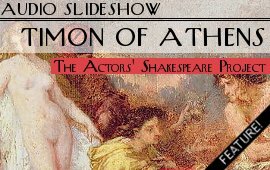
I can’t imagine a play that could better fit the M.O. of an “academic theater” (if you were to take that epaulet literally) than D.W. Jacobs’ R. Buckminster Fuller: The History (and Mystery) of the Universe. The ART’s current show takes the form of a meandering while didactic lecture, delivered by the inimitable Thomas Derrah. Distilled from the complete works of Buckminster Fuller, known today mostly for popularizing or re-inventing (read: not inventing) the and perhaps by generations older than myself as a popular futurist back when futurism didn’t itself seem retro, the play mixes biography with an everything-but-the-kitchen-sink recitation of Fuller’s ideas. Of course, Fuller left behind a lot of ideas and a lot of biography. His (Dymaxion was Fuller’s brand name, invented by the ad-man who’s credited with coining “radio”), an attempt by Fuller to scrapbook every 15 minutes of his life from 1920 to 1983, is said to run 270 ft. long. In 1975 he gave a 42-hour talk called “Everything I Know” (still below) whose “set” this production imitates. Jacobs has done most of the work for us here, trimming Fuller’s life and work into a swiftly moving and spoken two-acter that gives us a smattering of Fuller’s most relevant ideas on science, technology, education, sustainability, war, and economics. Our issues, more than ever, du jour.
Still from "Everything I know"

Thomas Derrah as Buckminster Fuller (Marcus Stern)
Derrah delivers this fictional lecture in a baggy three-piece suit, with the air of a tenured professor so confident in his age, position, and eccentricities that he feels comfortable digressing with authority whenever he likes. Sometimes seated in a high-backed Don’s chair, Derrah speaks lines of apparent wisdom in a smooth and articulate fey New England drawl. And we listen closely and work hard to digest what we can; partly because of Jacob’s elegant language and Derrah’s captivating delivery and partly because of the relevance and indisputability (at the surface, as delivered here) of Fuller’s ideas, but I think also very much because we get all this postmortem. We know Bucky isn’t a living character, but at the same time this doesn’t feel historical. David Cuthbert’s spacey set, featuring a colorful and dynamic circular disco floor at its center, forms a kind of pulpit of beyond the grave, or perhaps the future.
The didacticism that is here is punctuated by geometric magic tricks (did you know an icosahedron makes an octahedron which makes a tetrahedron?), whimsical interjections of song & dance, and less lucid, but no less profound, philosophical and autobiographical meanderings. Some viewers might desire more concrete and fleshed-out arguments–something extra to take home to a liberal Cambridge dinner table. But, if there were any more argument, R. Buckminster Fuller would cease to be a work of art and instead become a lecture by the lovechild of Bill McKibben and Ray Kurzweil. I preferred Bucky’s more abstract pondering on the spirituality of physics and biology to his nautical metaphor for the economics of Western civilization.
Cuthbert has shown some favoritism towards the house lights as Bucky often poses questions to his receptive audience, but also provides some spectacular color (as in the tableau below) worthy of Led Zeppelin night at the local geodesic planetarium. Jim Findlay’s projections were very well done; cutting stock footage of geodesic domes and the Dymaxion house and car with patent diagrams and photographs. In the spirit of the lecture, Bucky makes use of an on-stage overhead projector to illustrate concepts.

Thomas Derrah as Buckminster Fuller (Marcus Stern)
American Repertory Theater presents written and directed by D.W. Jacobs form the life, work, and writings of R. Buckminster Fuller performed by Thomas Derrah. Through February 5th at the Loeb. Tickets start at $25.




